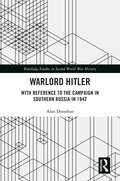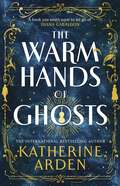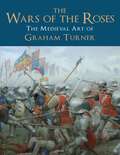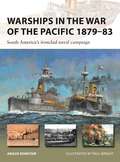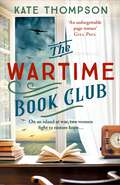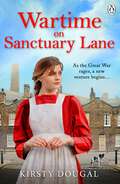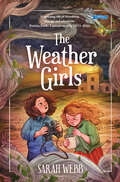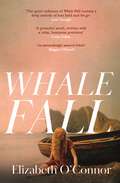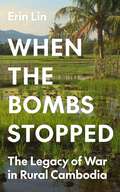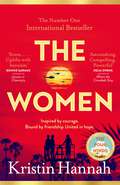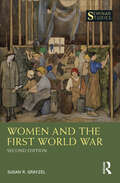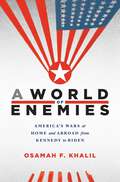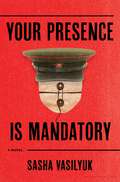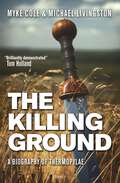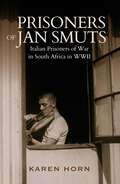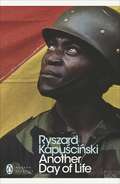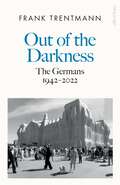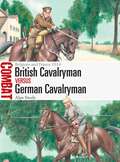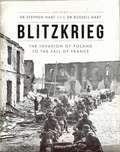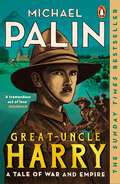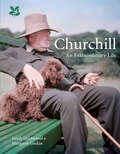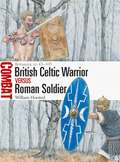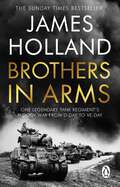- Table View
- List View
Warlord Hitler: With Reference to the Campaign in Southern Russia in 1942 (Routledge Studies in Second World War History)
by Alan DonohueThis book is a study of Adolf Hitler in his role as military commander and strategist from the beginning of the Second World War until the end of 1942, examining in detail the campaign in southern Russia that year. The thesis challenges the post-war narrative of Hitler as a dilettante who was solely responsible for the strategic and operational errors that led to Germany’s defeat in the war. Instead, this research highlights that decisions made by Hitler with respect to such disparate themes as strategy, operations, logistics, intelligence, economics, air and naval power, and coalition warfare were generally sound if viewed from his perspective, even if they were not ultimately successful. It also gives an overview of his own ideas concerning all aspects of military affairs, such as intelligence, command and morale. The careful analysis of Hitler’s decision-making process offers a unique contribution to Second World War scholarship and moves beyond a superficial understanding that the war’s outcome was a result of Hitler’s ineptitude as a military leader. Warlord Hitler will appeal to postgraduates and specialists in military history, as well as general readers interested in a deeper study of the Second World War.
The Warm Hands of Ghosts: the sweeping new novel from the international bestselling author
by Katherine ArdenThe sweeping new novel from New York Times bestselling author Katherine Arden.'A wonderful clash of fire and ice ... A book you won't want to let go of.' Diana Gabaldon'A spectacular tour de force ... I love this book so much and want everyone to read it!' Naomi Novik'Darkly beautiful and deeply humane ... The Warm Hands of Ghosts will stir your heart, and settle into your bones.' Ava Reid'Visionary, imaginative and brilliantly written.' Anthony Horowitz‘This exquisite novel took me over like a haunting ... One of the best historical fantasies I've ever read’ Emma Törzs______________World War One, and as shells fall in Flanders, a Canadian nurse searches for her brother believed dead in the trenches despite eerie signs that suggest otherwise in this gripping and powerful historical novel from the bestselling author of The Bear and the Nightingale.January 1918. Laura Iven has been discharged from her duties as a nurse and sent back to Halifax, Canada, leaving behind a brother still fighting in the trenches of the First World War. Now home, she receives word of Freddie's death in action along with his uniform -but something doesn't quite make sense. Determined to find out more, Laura returns to Belgium as a volunteer at a private hospital. Soon after arriving, she hears whispers about ghosts moving among those still living and a strange inn-keeper whose wine gives soldiers the gift of oblivion. Could this have happened to Freddie - but if so, where is he?November 1917. Freddie Iven awakens after an explosion to find himself trapped under an overturned pillbox with an enemy soldier, a German, each of them badly wounded. Against all odds, the two men form a bond and succeed in clawing their way out. But once in No Man's Land, where can either of them turn where they won't be shot as enemy soldiers or deserters? As the killing continues, they meet a man - a fiddler - who seems to have the power to make the hellscape that surrounds them disappear. But at what price?A novel of breath-taking scope and drama, of compulsive readability, of stunning historical research lightly worn, and of brilliantly drawn characters who will make you laugh and break your heart in a single line, The Warm Hands of Ghosts is a book that will speak to readers directly about the trauma of war and the power of those involved to love, endure and transcend it.______________More love for The Warm Hands of Ghosts . . .'Immersive and timeless, and an ode to the enduring power of memory.’ Vaishnavi Patel'A page-turner of the highest order ... A haunting, fantastic read!’ Helene Wecker'I absolutely devoured it!' Santa Montefiore'Wonderful storytelling. Inventive, haunting and deeply moving.' Sarah Winman'An exquisite, brilliant gem of a story.’ Conn Iggulden'Simply stunning.' Kate Quinn‘Absolutely incredible; I had chills all through reading it.' Shannon Chakraborty'Arden’s gripping historical fantasy will draw readers in and keep them engaged.' Library Journal, starred review'Lyrically beautiful prose, a brave heroine and a story shot through with the darkness of war' Daily Mail
The Wars of the Roses: The Medieval Art of Graham Turner
by Mr Graham TurnerA highly illustrated history of the Wars of the Roses based on the medieval art of Graham Turner.The period of civil strife in the second half of the 15th century now known as the Wars of the Roses was one of the most dramatic and tumultuous in English history. Since first being inspired by a visit to Bosworth battlefield nearly 30 years ago, renowned historical artist Graham Turner has built a worldwide reputation for his depictions of this colourful and troubled era, his paintings and prints prized by historians and collectors for their attention to detail and dramatic and atmospheric compositions. This new study contains a detailed history of the wars alongside a unique and comprehensive collection of over 120 of his paintings and drawings, many created especially for this book. It provides meticulously researched details of arms, armour, settings and countless other aspects of the period, while bringing to life the human stories behind the turbulent events.
Warships in the War of the Pacific 1879–83: South America's ironclad naval campaign (New Vanguard #328)
by Angus KonstamSuperbly illustrated with original artwork throughout, this book explores the ironclad warships that fought the little-known battles of South America's War of the Pacific. In the late 19th century, a war erupted between Chile and Peru, the catalyst for which was control of guano-rich Chincha islands. Given the geography of the two countries, with a narrow, arid land border and long exposed coastlines, it was inevitable that the War of the Pacific would predominantly be a naval war. It was a unique episode of military history, fought by two newly emergent South American states, using the latest technology – ironclad, steam-powered warships – and involving more naval battles than in the American Civil War, including a blockade, the capture of key warships, and bombardments of ports. Chile's navy was larger and more modern, while Peru's trump card was the small but powerful ironclad Huáscar. In this book, naval expert Angus Konstam offers readers an essential guide to this little-known naval war, illustrated with detailed profiles of the key ironclads, spectacular original artwork of the battles and a cutaway of Huáscar. He briefly covers the strategies of the warring powers as well as exploring all the key points of the naval campaign and the details of the warships involved, as a handful of ironclads fought for naval supremacy in South America.
The Wartime Book Club: the heart-warming and inspiring new novel of love, bravery and resistance in WW2
by Kate ThompsonJersey, 1943. Once a warm and neighbourly community, now German soldiers patrol the cobbled streets, imposing a harsh rule on the people of the island. Grace La Mottée, the island's only librarian, is ordered to destroy books which threaten the new regime. Instead, she hides the stories away in secret. Along with her headstrong best friend, postwoman Bea Rose, she wants to fight back. So she forms the wartime book club: a lifeline, offering fearful islanders the joy and escapism of reading. But as the occupation drags on, the women's quiet acts of bravery become more perilous - and more important - than ever before. And, when tensions turn to violence, they are forced to face the true, terrible cost of resistance . . . Based on astonishing real events, The Wartime Book Club is a love letter to the power of books in the darkest of times - as well as a moving page-turner that brings to life the remarkable, untold story of an island at war.EVERYONE LOVES THE WARTIME BOOK CLUB:'One of the very best books I've read in a long time. A gripping, emotional rollercoaster and a true hymn to the power and spirit of novels' Peter James'A poignant masterpiece that paints a vivid picture of Nazi-occupied life on the isle of Jersey' Madeline Martin'An engaging, beautifully researched story of love, courage and resistance in time of war and danger' Rachel Hore'Bravery, traitors, acts of defiance and compassion . . . [and] a beautiful and touching love story too' Pam Weaver'A wonderful, poignant, heartwarming story of the power of books and the strength of the human spirit' Louise Fein'This is a story of bravery and the cost of small acts of defiance . . . simply outstanding!' Andie Newton'An unforgettable page-turner' Gill Paul'A book to be savoured and remembered' Gill Thompson'With her brilliant research, Kate Thompson has brought this terrifying time vividly to life . . . a stunning novel' Suzanne Goldring'This, for me, is historical fiction at its finest - a story of believable, vividly-drawn people trying to live in a world so very different from our own - and I loved it from start to finish' Anna Stuart
Wartime on Sanctuary Lane: The first novel in a brand new WWI saga series (Sanctuary Lane #1)
by Kirsty DougalCall the Midwife meets All Creatures Great and Small in this brand-new saga series set in a WWI East End Animal Clinic. 'I was hooked from the start. The meticulous period detail and true-to-life characters had me immersed in the action, and I didn’t want the story to end. A joy to read' Vicki Beeby, author of The Ops Room Girls 'Superbly plotted ... a heartwarming and engrossing read' Maisie Thomas, author of Christmas with the Railway Girls --- In the carnage of war can one woman's courage be the light in the dark? As the Great War rages across Europe, twenty-one-year-old Ruby Archer decides to ‘do her bit’ at an East End munitions factory. The work is relentless and deafening, but the camaraderie of the other girls carries her through. As London continues to be ravaged by German bombs, Ruby can’t ignore the abandoned animals scavenging the local streets. Mustering all of her courage, she decides to take action and open a weekly animal clinic. But opposition quickly closes in, when there is a war to win surely all efforts must be for the troops. With the help of her friends, can this East End girl show everyone that in wartime every life matters?--- Readers love Wartime on Sanctuary Lane: ‘A wonderful wartime family saga not to be put down’ ***** Reader Review ‘Beautiful... [I] loved it’ ***** Reader Review‘This book was BRILLIANT! I loved the characters - especially Ruby and Leah - both very interesting young women in very different ways’ ***** Reader Review‘I cannot wait to find out what happens next. I'm definitely keen to read more books by Kirsty!’ ***** Reader Review ‘Wow what can I say what a brilliant book… [I] loved it’ ***** Reader Review
The Weather Girls
by Sarah WebbIt's 1944. Twelve-year-old Grace Devine lives at Blacksod Lighthouse and weather station in County Mayo with her parents and little brother. When a German plane crashes nearby, she and her best friend Sibby risk their lives to save the young pilot. Grace's family take him in, but their neighbours are horrified at having an 'enemy' in their midst. Meanwhile, the Met Office in England suddenly asks Blacksod to send them weather reports every hour. But why? As the wind and rain howl outside, Grace begins to understand that something important is happening, something to do with the war – and she is right in the eye of the storm. A tale of bravery, adventure and a remarkable friendship, inspired by true events from World War 2.
Whale Fall: One of the Observer's Top Ten Debuts of 2024
by Elizabeth O'Connor'I didn't want it to end' - Maggie O'Farrell'Powerful . . . written with a calm, luminous precision' - Colm TóibínAn Observer Best Debut of the Year 2024It is 1938 and for Manod, a young woman living on a remote island off the coast of Wales, the world looks ready to end just as she is trying to imagine a future for herself. The ominous appearance of a beached whale on the island's shore, and rumours of submarines circling beneath the waves, have villagers steeling themselves for what’s to come. Empty houses remind them of the men taken by the Great War, and of the difficulty of building a life in the island's harsh, salt-stung landscape.When two anthropologists from the mainland arrive, Manod sees in them a rare moment of opportunity to leave the island and discover the life she has been searching for. But, as she guides them across the island’s cliffs, she becomes entangled in their relationship, and her imagined future begins to seem desperately out of reach.Elizabeth O’Connor’s beautiful, devastating debut Whale Fall tells a story of longing and betrayal set against the backdrop of a world on the edge of great tumult.'The quiet cadences of Whale Fall contain a deep melody of loss held and let go. It is a gentle, tough story about profound change' - Anne Enright
When the Bombs Stopped: The Legacy of War in Rural Cambodia (Princeton Studies in International History and Politics #206)
by Erin LinHow undetonated bombs from a war that ended more than fifty years ago still affect Cambodian farmers and their land Over the course of the Vietnam War, the United States dropped 500,000 tons of bombs over Cambodia—more than the combined weight of every man, woman, and child in the country. What began as a secret CIA infiltration of Laos eventually expanded into Cambodia and escalated into a nine-year war over the Ho Chi Minh trail fought primarily with bombs. Fifty years after the last sortie, residents of rural Cambodia are still coping with the unexploded ordnance that covers their land. In When the Bombs Stopped, Erin Lin investigates the consequences of the US bombing campaign across postconflict Cambodia.Drawing on interviews, original econometric analysis, and extensive fieldwork, Lin upends the usual scholarly perspective on the war and its aftermath, presenting the viewpoint of those who suffered the bombing rather than those who dropped the bombs. She shows that Cambodian farmers stay at a subsistence level because much of their land is too dangerous to cultivate—and yet, paradoxically, the same bombs that endanger and impoverish farming communities also protect them, deterring predatory elites from grabbing and commodifying their land. Lin argues that the half-century legacy of American bombs has sedimented the war into the layers of contemporary Cambodian society. Policies aimed at developing or modernizing Cambodia, whether economic liberalization or authoritarian consolidation, must be realized in an environment haunted by the violence of the past. As the stories Lin captures show, the bombing served as a critical juncture in these farming villages, marking the place in time where development stopped.
When the Bombs Stopped: The Legacy of War in Rural Cambodia (Princeton Studies in International History and Politics #206)
by Erin LinHow undetonated bombs from a war that ended more than fifty years ago still affect Cambodian farmers and their land Over the course of the Vietnam War, the United States dropped 500,000 tons of bombs over Cambodia—more than the combined weight of every man, woman, and child in the country. What began as a secret CIA infiltration of Laos eventually expanded into Cambodia and escalated into a nine-year war over the Ho Chi Minh trail fought primarily with bombs. Fifty years after the last sortie, residents of rural Cambodia are still coping with the unexploded ordnance that covers their land. In When the Bombs Stopped, Erin Lin investigates the consequences of the US bombing campaign across postconflict Cambodia.Drawing on interviews, original econometric analysis, and extensive fieldwork, Lin upends the usual scholarly perspective on the war and its aftermath, presenting the viewpoint of those who suffered the bombing rather than those who dropped the bombs. She shows that Cambodian farmers stay at a subsistence level because much of their land is too dangerous to cultivate—and yet, paradoxically, the same bombs that endanger and impoverish farming communities also protect them, deterring predatory elites from grabbing and commodifying their land. Lin argues that the half-century legacy of American bombs has sedimented the war into the layers of contemporary Cambodian society. Policies aimed at developing or modernizing Cambodia, whether economic liberalization or authoritarian consolidation, must be realized in an environment haunted by the violence of the past. As the stories Lin captures show, the bombing served as a critical juncture in these farming villages, marking the place in time where development stopped.
The Women: Powerful and heartbreaking, the eagerly awaited novel everyone is talking about for 2024
by Kristin Hannah'Astonishing. Compelling. Powerful' – Delia Owens, bestselling author of Where the Crawdads Sing'Stuns with sacrifice. Uplifts with heroism' – Bonnie Garmus, bestselling author of Lessons in ChemistryFrom the worldwide bestselling author of The Four Winds, The Nightingale and Firefly Lane (a Number One series on Netflix), The Women is a story of devastating loss and epic love. It would be the journey of a lifetime . . .‘Women can be heroes, too’. When twenty-year-old nursing student, Frances “Frankie” McGrath, hears these unexpected words, it is a revelation. Raised on California’s idyllic Coronado Island and sheltered by her conservative parents, she has always prided herself on doing the right thing, being a good girl. But in 1965 the world is changing, and she suddenly imagines a different path for her life. When her brother ships out to serve in Vietnam, she impulsively joins the Army Nurses Corps and follows his path.As green and inexperienced as the young men sent to Vietnam to fight, Frankie is overwhelmed by the chaos and destruction of war, as well as the unexpected trauma of coming home to a changed America. Frankie will also discover the true value of female friendship and the heartbreak that love can cause.Praise for Kristin Hannah:‘Powerful and compelling’ – Christy Lefteri, bestselling author of The Beekeeper of Aleppo‘You would be hard-pressed to find a book club that has not discussed one of her novels’ – New York Times‘A rich, compelling novel of love, sacrifice and survival’ – Kate Morton‘A masterclass’ – Karen Swan‘Powerful’ – Matt Haig
Women and the First World War (Seminar Studies)
by Susan R. GrayzelIn this revised version of a ground-breaking global history of women and the First World War, Susan Grayzel shows the multiple ways in which women faced the enormous challenges the war presented, both the losses as well as the opportunities that the war provided. The First World War was a total war requiring the mobilisation of millions of both civilians and combatants. It decisively shaped the modern world. A century after the signing of the last peace treaty to end this conflict, its experiences and legacies for women continue to inspire debate and interest. With new evidence from the tremendous outpouring of scholarship on women in all participant states, including those in occupied territories, Europe and its overseas empires, Asia, the Middle East, Africa and the United States over the last twenty years, this edition greatly expands the coverage of the war geographically while continuing to showcase diverse women’s voices. Topical in its approach, it allows for a thorough exploration of the intersectional experiences of women. Including new documents highlighting the ways in which women wrote their wars and that detail the impact of this conflict on women of different statuses and geographies, this book opens the door to further inquiry on the women of the First World War. With documents providing first-hand accounts, a chronology and a glossary, the book is an ideal text for students studying the First World War or the history of women.
Women and the First World War (Seminar Studies)
by Susan R. GrayzelIn this revised version of a ground-breaking global history of women and the First World War, Susan Grayzel shows the multiple ways in which women faced the enormous challenges the war presented, both the losses as well as the opportunities that the war provided. The First World War was a total war requiring the mobilisation of millions of both civilians and combatants. It decisively shaped the modern world. A century after the signing of the last peace treaty to end this conflict, its experiences and legacies for women continue to inspire debate and interest. With new evidence from the tremendous outpouring of scholarship on women in all participant states, including those in occupied territories, Europe and its overseas empires, Asia, the Middle East, Africa and the United States over the last twenty years, this edition greatly expands the coverage of the war geographically while continuing to showcase diverse women’s voices. Topical in its approach, it allows for a thorough exploration of the intersectional experiences of women. Including new documents highlighting the ways in which women wrote their wars and that detail the impact of this conflict on women of different statuses and geographies, this book opens the door to further inquiry on the women of the First World War. With documents providing first-hand accounts, a chronology and a glossary, the book is an ideal text for students studying the First World War or the history of women.
A World of Enemies: America’s Wars at Home and Abroad from Kennedy to Biden
by Osamah F. KhalilA sobering account of how the United States trapped itself in endless wars—abroad and at home—and what it might do to break free.Over the past half-century, Americans have watched their country extend its military power to what seemed the very ends of the earth. America’s might is felt on nearly every continent—and even on its own streets. Decades ago, the Wars on Drugs and Terror broke down the walls separating law enforcement from military operations. A World of Enemies tells the story of how an America plagued by fears of waning power and influence embraced foreign and domestic forever wars.Osamah Khalil argues that the militarization of US domestic and foreign affairs was the product of America’s failure in Vietnam. Unsettled by their inability to prevail in Southeast Asia, US leaders increasingly came to see a host of problems as immune to political solutions. Rather, crime, drugs, and terrorism were enemies spawned in “badlands”—whether the Middle East or stateside inner cities. Characterized as sites of endemic violence, badlands lay beyond the pale of civilization, their ostensibly racially and culturally alien inhabitants best handled by force.Yet militarized policy has brought few victories. Its failures—in Iraq, Afghanistan, US cities, and increasingly rural and borderland America—have only served to reinforce fears of weakness. It is time, Khalil argues, for a new approach. Instead of managing never-ending conflicts, we need to reinvest in the tools of traditional politics and diplomacy.
Your Presence Is Mandatory: A Novel
by Sasha VasilyukA riveting debut novel, based on real events, about a World War II veteran with a secret that could land him in the Gulag, and his family who are forced to live in the shadow of all he has not told them.Ukraine, 2007. Yefim Shulman, husband, grandfather and war veteran, was beloved by his family and his coworkers. But in the days after his death, his widow Nina finds a letter to the KGB in his briefcase. Yefim had a lifelong secret, and his confession forces them to reassess the man they thought they knew and the country he had defended.In 1941, Yefim is a young artillerist on the border between the Soviet Union and Germany, eager to defend his country and his large Jewish family against Hitler's forces. But surviving the war requires sacrifices Yefim never imagined-and even when the war ends, his fight isn't over. He must conceal his choices from the KGB and from his family. Spanning seven decades between World War II and the current Russia-Ukraine conflict, Your Presence Is Mandatory traces the effect Yefim's coverup had on the lives of Nina, their two children and grandchildren. In the process, Sasha Vasilyuk shines a light on one family caught between two totalitarian regimes, and the grace they find in the course of their survival.
The Killing Ground: A Biography of Thermopylae
by Myke Cole Dr Michael LivingstonAn exploration into why and how Thermopylae is one of the most blood-soaked patches of ground in history – and what its past can tell us about our future.'Brilliantly demonstrated.' - Tom HollandSince the dawn of the Classical Era up to World War II, thousands have lost their lives fighting over the pass at Thermopylae. Historians Cole and Livingston provide an exciting account of each of the 27 battles and holding actions that took place. The epic events of 480 BC when 300 Spartans attempted to hold the pass has been immortalised in poetry, art, literature and film. But no history has ever detailed the other events from the very first battle through to the battles fought by Romans, Byzantines, Huns and Ottomans during the early and late medieval periods and finally the two desperate struggles against German occupying forces during World War II. The Killing Ground details the background and history of each conflict, the personalities and decision making of the commanders, the arms and tactics of the troops, and how each battle played out. Cole and Livingston have surveyed the ground to provide a boots-on understanding of each battle. Their command of multiple ancient and medieval languages means they have provided their own translations of much of the source material, ensuring new insights into each battle. This uncompromising scholarship is woven together into a compelling and unforgettable history that grips the reader from start to finish.
Prisoners of Jan Smuts: Italian Prisoners of War in South Africa in WWII
by Karen HornEqually skilled in a variety of trades other than in the art of love, the Italian prisoners of war (POWs) who were incarcerated in South Africa during the Second World War are a source of great fascination to this day. Who were these men? And what made some of them attempt dramatic escapes, while others wanted to stay behind after the war? The first Italian POWs arrived in the Union of South Africa in early 1941, most of them being held in Zonderwater Camp outside Cullinan or in work camps across the country. The government of Jan Smuts saw them as a source of cheap labour that would contribute to harvesting schemes, road-building projects such as the old Du Toit's Kloof Pass between Paarl and Worcester and even to prickly-pear eradication schemes. Prisoners of Jan Smuts recounts the stories of survival and shenanigans of the Italian POWs in the Union through the eyes of five prisoners who had documented their experiences in memoirs and letters. While many POWs seemed to appreciate the opportunities to gain new skills, others clung to the Fascist ideas they had grown up with and refused to work. Many opted to remain in South Africa once the war had ended, forging quite a legacy. These included sculptor Edoardo Villa, who left an important mark in the local and international art world, and businessman Aurelio Gatti, who built an ice-cream empire whose gelato was to delight generations of South Africans.
Another Day of Life (Forsyte chronicles)
by Ryszard Kapuscinski William Brand'This is a very personal book, about being alone and lost'. In 1975 Kapuscinski's employers sent him to Angola to cover the civil war that had broken out after independence. For months he watched as Luanda and then the rest of the country collapsed into a civil war that was in the author's words 'sloppy, dogged and cruel'. In his account, Kapuscinski demonstrates an extraordinary capacity to describe and to explain the individual meaning of grand political abstractions.
Out of the Darkness: The Germans, 1942-2022
by Frank TrentmannA groundbreaking new history of the people at the centre of Europe, from the Second World War to todayIn 1945, Germany lay in ruins, morally and materially. The German people stood condemned by history, responsible for a horrifying genocide and a war of extermination. But by 2015 Germany looked to many to be the moral voice of Europe, welcoming almost one million refugees. At the same time, it pursued a controversially rigid fiscal discipline and made energy deals with a dictator. Many people have asked how Germany descended into the darkness of the Nazis, but this book asks another vital question: how, and how far, have the Germans since reinvented themselves?Trentmann tells the dramatic story of the Germans from the middle of the Second World War, through the Cold War and the division into East and West, to the fall of the Berlin Wall and the reunited nation's search for a place in the world. Their journey is marked by extraordinary moral struggles: guilt, shame and limited amends; wealth versus welfare; tolerance versus racism; compassion and complicity. Through a range of voices - German soldiers and German Jews; environmentalists and coal miners; families and churches; volunteers, migrants and populists - Trentmann paints a remarkable and surprising portrait over 80 years of the conflicted people at the centre of Europe.
British Cavalryman vs German Cavalryman: Belgium and France 1914 (Combat)
by Alan SteeleFully illustrated, this book casts light on the utility and role of the German and British cavalry in the early stages of World War I on the Western Front.In the early months of World War I, before the fighting degenerated into static trench warfare, there was a brief period of mobile combat as the German Army advanced through Belgium and northern France, forcing the French and British forces facing them to retreat. Both sides in the escalating conflict deployed substantial numbers of cavalry units to screen their infantry forces, conduct reconnaissance and harness their superior mobility to undertake aggressive combat operations. In the summer of 1914, the British cavalry had the difficult task of covering the withdrawal of the British Expeditionary Force and the German cavalry, the equally demanding task, after weeks of combat and forced marches, of maintaining contact with a rapidly retiring enemy.In this book a comparative assessment is made of each side's doctrine, organization, equipment and training, followed by a detailed analysis of their actual performance in three key encounter actions: Casteau/Soignies (22 August), Cérizy/Moÿ (28 August) and Le Montcel/Frétoy (7 September). This analysis is supported by carefully chosen photographs and specially commissioned full-colour artwork and maps.
Blitzkrieg: The Invasion of Poland to the Fall of France
by Stephen A. Hart Russell HartA fascinating study of the devastating new form of warfare that redrew the map of Europe in the opening year of World War II, bringing about the military collapse of three modern industrialized armies. On 1 September 1939, Nazi Germany launched the invasion of Poland, employing a new type of offensivewarfare: Blitzkrieg. So named by Allied observers because of the shock and rapidity of its effects, this newapproach was based on speed, manoeuvrability and concentration of firepower. The strategy saw startlingsuccess as the panzer divisions, supported by Stuka dive-bombers, spread terror and mayhem, reachingWarsaw in just one week. Aided by the intervention of the Soviet Union in the east, the campaign was overin a mere 36 days.This astonishing feat was followed by Operation Weserübung, the invasion of Denmark and then Norway in1940, the first joint air-sea-land campaign in the history of warfare. Even more striking an achievement wasthe swift and conclusive defeat of France during May–June 1940. Refusing to let its forces dash themselvesagainst the fortifications of the Maginot Line, Germany instead sent its divisions through neutral Belgiumand northern France in Fall Gelb ('Case Yellow'), destroying Allied resistance and pursuing the remnant ofthe British and French forces to Dunkirk in an audacious and devastatingly effective assault. During thecourse of Fall Rot ('Case Red') over the following 20 days, German forces pressed the attack and by 25 Junehad forced France's leaders into a humiliating capitulation.Illustrated throughout with detailed maps, artwork and contemporary photographs, Blitzkrieg: TheInvasion of Poland to the Fall of France tells the story of these first breakneck attacks, examining the armedforces, leaders, technology, planning and execution in each campaign as well as the challenges faced by theGermans in the pursuit of this new and deadly form of warfare.
Great-Uncle Harry: A Tale of War and Empire
by Michael Palin'An important historical record and a well-paced story in its own right, Great-Uncle Harry is also much more than that: a tremendous act of love.' Guardian___________________________________From the time, many years ago, when Michael Palin first heard that his grandfather had a brother, Harry, he was determined to find out more about him.The quest that followed involved hundreds of hours of painstaking detective work. Michael dug out every bit of family gossip and correspondence he could. He studied every relevant official document. He tracked down what remained of his great-uncle Harry's diaries and letters, and pored over photographs of First World War battle scenes to see whether Harry appeared in any of them. He walked the route Harry took on that fatal, final day of his life amid the mud of northern France. And as he did so, a life that had previously existed in the shadows was revealed to him.Great-Uncle Harry is an utterly compelling account of an ordinary man who led an extraordinary life. A blend of biography, history, travelogue and personal memoir this is Michael Palin at his very finest.___________________________________________PRAISE FOR EREBUS:'Beyond terrific. I didn't want it to end.' BILL BRYSON'Magisterial . . . Palin brings energy, wit and humanity to a story that has never ceased to tantalise people.' THE TIMES'Everybody's talking about it . . . A brilliant book.' CHRIS EVANS'I absolutely loved it: I had to read it at one sitting.' LORRAINE KELLY
Churchill: An Extraordinary Life
by Sarah Gristwood Margaret Gaskin National Trust BooksA short illustrated life of one of Britain's most revered people of all time, covering all periods of his life but always returning to his literal and spiritual home, Chartwell.
British Celtic Warrior vs Roman Soldier: Britannia AD 43–105 (Combat)
by William HorstedAn illustrated study of the British tribal warriors and Roman auxiliaries who fought in three epic battles for control of Britain in the 1st century AD. Following the Roman invasion of Britain in AD 43, the tribes of the west and north resisted the establishment of a 'Roman peace', led in particular by the chieftain Caratacus. Even in the south-east, resentment of Roman occupation remained, exploding into the revolt of Boudicca's Iceni in AD 60. Roman auxiliaries from two particular peoples are known to have taken part in the invasion of Britain: the Tungrians, from what is now Belgium, and the Batavians, from the delta of the River Rhine in the modern Netherlands. From the late 80s AD, units of both the Batavians and the Tungrians were garrisoned at a fort at Vindolanda in northern Britain. The so called 'Vindolanda tablets' provide an unparalleled body of material with which to reconstruct the lives of these auxiliary soldiers in Britain.Featuring full-colour maps and specially commissioned battlescene and figure artwork plates, this book examines how both the British warriors and the Roman auxiliaries experienced the decades of conflict that followed the invasion. Their recruitment, training, leadership, motivation, culture and beliefs are compared alongside an assessment of three particular battles: the final defeat of Caratacus in the hills of Wales in AD 50; the Roman assault on the island of Mona (Anglesey) in AD 60; and the battle of Mons Graupius in Scotland in AD 83.
Brothers in Arms: One Legendary Tank Regiment's Bloody War from D-Day to VE-Day
by James HollandFrom the bestselling author of Normandy '44 and Sicily '43, a brilliant new history of the last days of the war'Seldom is war so vividly described...An assault on the senses...Painful to read, impossible to put down' Gerard DeGroot, The TimesIt took a certain type of courage to serve in a tank in the Second World War. Encased in steel, surrounded by highly explosive shells, a big and slow-moving target, every crew member was utterly vulnerable to enemy attack from all sides. Living - and dying - in a tank was a brutal way to fight a war.The Sherwood Rangers were one of the great tank regiments. They had learned their trade the hard way, in the burning deserts of North Africa. From D-Day onwards, they were in the thick of the action til the war's end. They and their Sherman tanks covered thousands of miles and endured some of the fiercest fighting in Western Europe. Their engagements stretch from the Normandy beaches to the bridges at Eindhoven. They were the first British unit into Germany, grinding across the Siegfried Line and on into the Nazi heartland.Through compelling eye-witness testimony and James Holland's expert analysis, Brothers In Arms brings to vivid life the final bloody scramble across Europe and gives the most powerful account to date of what it was really like to fight in the dying days of World War Two.
